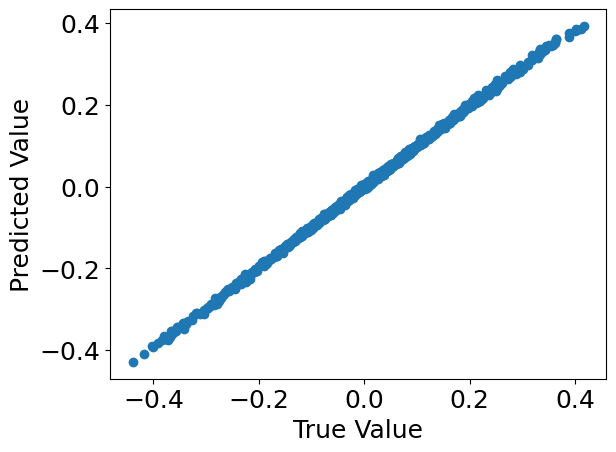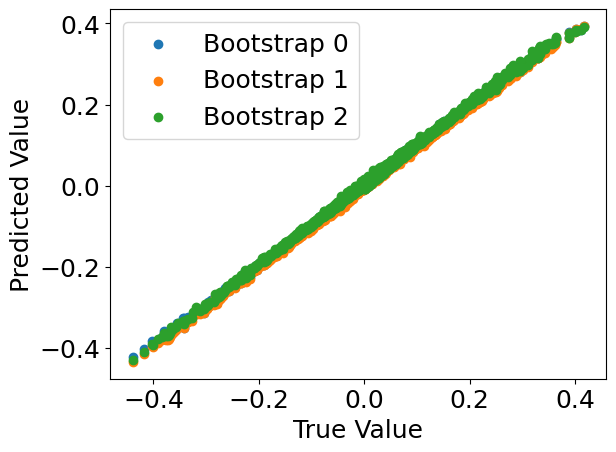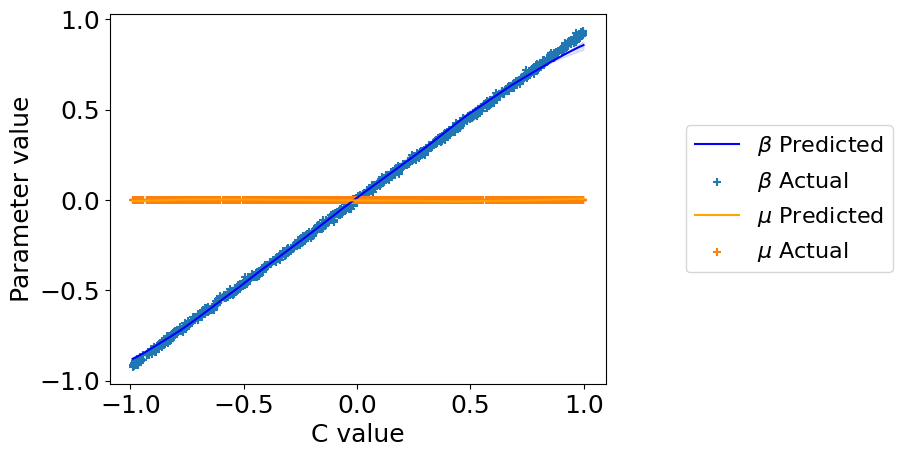Contextualized Regression#
Contextual models allow to identify heterogeneous effects which change between different contexts. The contextualized package provides easy access to these heterogeneous models through the contextualized.easy module interfaces. This notebook shows a simple example of using contextualized.easy regression.
1. Generate Simulation Data#
In this simulated regression, we’ll study the simple varying-coefficients case where \(Y =X\beta(C) + \epsilon\), with \(\beta(C) \sim \text{N}(C\phi, \text{I})\), and \(\epsilon \sim \text{N}(0, 0.01 \text{I})\).
\(Y\): The dependent or output variable.
\(X\): The independent or predictor variable.
\(\beta(C)\): The coefficients of the regression model, which vary depending on the context \(C\).
\(C\): The context variable that influences the coefficients \(\beta\).
\(\phi\): A parameter vector that influences how the context \(C\) impacts the coefficients \(\beta(C)\).
\(I\): The identity matrix, used to define the variance of the normal distributions.
\(\epsilon\): The error term, representing random noise in the data. Can be ignored when predicting \(Y\) given \(X\).
\(\sim \text{N}(\mu, \sigma^2)\): Indicates a normal distribution with mean \(\mu\) and variance \(\sigma^2\).
import numpy as np
n_samples = 1000
n_outcomes = 3
n_context = 1
n_observed = 1
C = np.random.uniform(-1, 1, size=(n_samples, n_context))
X = np.random.uniform(0, 0.5, size=(n_samples, n_observed))
phi = np.random.uniform(-1, 1, size=(n_context, n_observed, n_outcomes))
beta = np.tensordot(C, phi, axes=1) + np.random.normal(0, 0.01, size=(n_samples, n_observed, n_outcomes))
Y = np.array([np.tensordot(X[i], beta[i], axes=1) for i in range(n_samples)])
2. Build and fit model#
The contextualized.easy models use an sklearn-type wrapper interface. More details about the specific implementation can be found in the documentation.
%%capture
from contextualized.easy import ContextualizedRegressor
model = ContextualizedRegressor()
model.fit(C, X, Y, max_epochs=20, learning_rate=1e-3, n_bootstraps=3)
3. Inspect the model predictions.#
%%capture
import matplotlib.pyplot as plt
%matplotlib inline
preds = model.predict(C, X)[:, 0]
plt.rcParams.update({'font.size': 18})
plt.scatter(Y[:, 0], preds)
plt.xlabel("True Value")
plt.ylabel("Predicted Value")
plt.show()

4. Check what the individual bootstrap models learned.#
Bootstrapping is a resampling method that involves creating multiple samples from the original dataset by sampling with replacement. Each bootstrap sample is used to train different instances of a model, resulting in a collection of models that learned from varying data. This approach improves model robustness and provides insight into the variability of predictions.
For more information, refer to this resource on bootstrapping.
%%capture
model_preds = model.predict(C, X, individual_preds=True)
for i, pred in enumerate(model_preds):
plt.scatter(Y[:, 0], pred[:, 0], label='Bootstrap {}'.format(i))
plt.xlabel("True Value")
plt.ylabel("Predicted Value")
plt.legend()
plt.show()

5. Check what parameters the models learned.#
%%capture
beta_preds, mu_preds = model.predict_params(C, individual_preds=True)
order = np.argsort(C.squeeze()) # put C in order for plotting
C = C[order].squeeze()
beta_preds = beta_preds[:, order]
mu_preds = mu_preds[:, order]
beta = beta[order]
plt.plot(
C, np.mean(beta_preds[:, :, 0], axis=0),
label='$\\beta$ Predicted', color='blue')
plt.fill_between(
C,
np.percentile(beta_preds[:, :, 0], 2.5, axis=0).squeeze(),
np.percentile(beta_preds[:, :, 0], 97.5, axis=0).squeeze(),
color='blue', alpha=0.1
)
plt.scatter(C, beta[:, :, 0], label='$\\beta$ Actual', marker='+')
plt.plot(
C, np.mean(mu_preds[:, :, 0], axis=0),
label='$\\mu$ Predicted', color='orange')
plt.fill_between(
C,
np.percentile(mu_preds[:, :, 0], 2.5, axis=0).squeeze(),
np.percentile(mu_preds[:, :, 0], 97.5, axis=0).squeeze(),
color='orange', alpha=0.1
)
plt.scatter(C, np.zeros_like(C), label='$\\mu$ Actual', marker='+')
plt.legend(loc='center right', bbox_to_anchor=(1.6, 0.5), fontsize=16)
plt.xlabel("C value")
plt.ylabel("Parameter value")
plt.show()

6. Save/load the trained model.#
from contextualized.utils import save, load
save_path = './easy_demo_model.pt'
save(model, path=save_path)
model = load(save_path)
